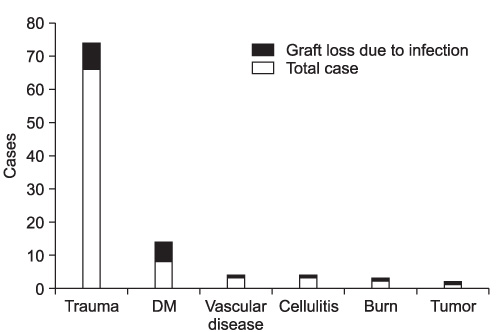J Korean Orthop Assoc.
2012 Apr;47(2):119-124. 10.4055/jkoa.2012.47.2.119.
Analysis of Factors That Affect the Outcome of Skin Grafts
- Affiliations
-
- 1Department of Orthopedic Surgery, Busan Paik Hospital, College of Medicine, Inje University, Busan, Korea. kimjunghan74@gmail.com
- KMID: 2185387
- DOI: http://doi.org/10.4055/jkoa.2012.47.2.119
Abstract
- PURPOSE
This study aimed to investigate factors that affect the successful outcome of skin grafts.
MATERIALS AND METHODS
One-hundred and one patients undergoing split-thickness skin grafts were reviewed between March 2000 and March 2008. The mean age of the patients was 39 years (16 to 67 years). The numbers of male and female patients were 63 (62.4%) and 38 (37.6%), respectively. The average follow up period was 8 weeks (2 to 23 weeks). For the analysis, patients were classified by patient factors and wound factors affecting the outcome of skin grafts. The criteria for the successful outcome of skin grafts were as follows: over 80% of skin ingestion rate, no exposure of subcutaneous tissue, no distinct signs of infection, and no need for reoperation. Also, statistical analysis was used to identify the correlation between each factor regarding the outcome of each skin graft.
RESULTS
The preoperative serum levels of c-reactive protein (CRP) and white blood cell (WBC) were significantly correlated with the success of skin grafts (p<0.05). The cut-off value of WBC and CRP were 10.500x103/microl and 1.02 mg/dl, respectively. Each factor showed 27.6 and 9.5 times of association strength.
CONCLUSION
Among the various factors, the preoperative serum levels of CRP and WBC had significant correlations regarding the successful outcome of skin grafts. This result suggests that those levels can be objective indexes to predict the outcome of skin grafts.
MeSH Terms
Figure
Reference
-
1. Argenta LC, Morykwas MJ. Vacuum-assisted closure: a new method for wound control and treatment: clinical experience. Ann Plast Surg. 1997. 38:563–576.2. Gallico GG 3rd. Biologic skin substitutes. Clin Plast Surg. 1990. 17:519–526.3. Kunert P. Structure and construction: the system of skin flaps. Ann Plast Surg. 1991. 27:509–516.
Article4. Tanner JC Jr, Vandeput J, Olley JF. The mesh skin graft. Plast Reconstr Surg. 1964. 34:287–292.5. Rowe NM, Morris L, Delacure MD. Acellular dermal composite allografts for reconstruction of the radial forearm donor site. Ann Plast Surg. 2006. 57:305–311.
Article6. Johnson CS, Preuss HS, Eriksson E. Sabiston DC, editor. Plastic surgery. Sabiston Textbook of surgery: the biologic basis of modern surgical practice. 2001. Philadelphia: Saunders;1553–1554.7. McDowell F. The source book of plastic surgery. 1977. Baltimore: Williams and Wilkins;1–52.8. Barret JP, Herndon DN, McCauley RL. Use of previously burned skin as random cutaneous local flaps in pediatric burn reconstruction. Burns. 2002. 28:500–502.
Article9. McGregor AD, McGregor I. McGregor AD, McGregor I, editors. Free skin grafts. Fundamental techniques of plastic surgery. 2000. 10th ed. Philadelphia: Churchill Livingstone;35–59.
Article10. Edwards-Jones V, Greenwood JE. Manchester Burns Research Group. What's new in burn microbiology? James Laing Memorial Prize Essay 2000. Burns. 2003. 29:15–24.11. Elliott D, Kufera JA, Myers RA. The microbiology of necrotizing soft tissue infections. Am J Surg. 2000. 179:361–366.
Article12. Stevens DL. The flesh-eating bacterium: what's next? J Infect Dis. 1999. 179:Suppl 2. S366–S374.
Article13. Mangram AJ, Horan TC, Pearson ML, Silver LC, Jarvis WR. Hospital Infection Control Practices Advisory Committee. Guideline for prevention of surgical site infection, 1999. Infect Control Hosp Epidemiol. 1999. 20:250–278.
Article14. Wu X, Kathuria N, Patrick CW, Reece GP. Quantitative analysis of the microvasculature growing in the fibrin interface between a skin graft and the recipient site. Microvasc Res. 2008. 75:119–129.
Article15. Chick LR. Brief history and biology of skin grafting. Ann Plast Surg. 1988. 21:358–365.
Article16. Hauben DJ, Baruchin A, Mahler A. On the histroy of the free skin graft. Ann Plast Surg. 1982. 9:242–245.17. Nakayama Y, Chuang YM. A scalpel blade as a substitute for the calibrator of the dermatome. Plast Reconstr Surg. 1983. 72:405–407.
Article18. Padgett EC. Calibrated intermediate skin grafts. Plast Reconstr Surg. 1967. 39:195–209.19. Polk HC. Supportive therapy in burn care. Consensus summary on infection. J Trauma. 1979. 19:894–896.20. Robson MC, Krizek TJ. Predicting skin graft survival. J Trauma. 1973. 13:213–217.
Article21. Thourani VH, Ingram WL, Feliciano DV. Factors affecting success of split-thickness skin grafts in the modern burn unit. J Trauma. 2003. 54:562–568.
Article22. Paletta CE, Pokorny JJ, Rumbolo P. Mathes SJ, editor. Skin grafts. Plastic Surgery. 2006. Philadelphia: Saunders Elsevier;293–316.23. Scherer LA, Shiver S, Chang M, Meredith JW, Owings JT. The vacuum assisted closure device: a method of securing skin grafts and improving graft survival. Arch Surg. 2002. 137:930–933.24. Ablove RH, Howell RM. The physiology and technique of skin grafting. Hand Clin. 1997. 13:163–173.
Article25. Ratner D. Skin grafting. Semin Cutan Med Surg. 2003. 22:295–305.
Article
- Full Text Links
- Actions
-
Cited
- CITED
-
- Close
- Share
- Similar articles
-
- Autologous Epidermal Sheet Grafts Using a Suction Blister in Two Cases with Skin Ulcers
- Skin Grafts on Bare Bone
- Use of a Barbed Suture Tie-Over Technique for Skin Graft Dressings: A Case Series
- Efficacy of Tie-over Dressing Using Silicone Gel Sheet in Skin Graft on Flat Surface
- Effect of Some Immunosuppressive Agents on the Survival of Experimental Skin Homografts in Rats I. Effect of Total Body Irradiation, Imuran, Prednisolone and Splenectomy



